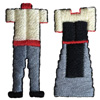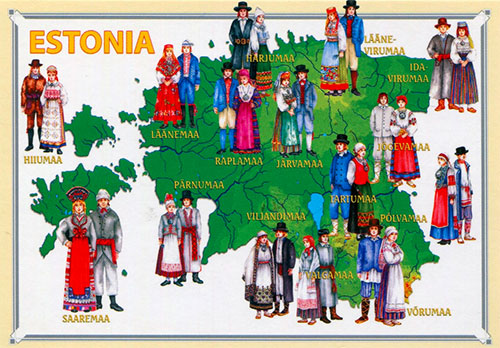 Estonia is one of those European countries that preserve old traditions and are very serious about the national heritage. Their authentic folk clothing is kept in museums in special cold stores to prolong its life and preserve it for future generations. At the same time, many Estonians have modern replicas of traditional outfits, which they wear for special occasions, national holidays, folklore festivals, etc. This country has never been really wealthy – and we can see that by the local folk costumes (no massive gold jewelry, expensive furs, strings of pearls, or fancy silks) – but these people managed to turn their traditional garments into works of art.
Estonia is one of those European countries that preserve old traditions and are very serious about the national heritage. Their authentic folk clothing is kept in museums in special cold stores to prolong its life and preserve it for future generations. At the same time, many Estonians have modern replicas of traditional outfits, which they wear for special occasions, national holidays, folklore festivals, etc. This country has never been really wealthy – and we can see that by the local folk costumes (no massive gold jewelry, expensive furs, strings of pearls, or fancy silks) – but these people managed to turn their traditional garments into works of art.
The national attire of Estonia is rather diverse, there are about 100 variations of the traditional costume depending on the region, social status of the wearer, marital status, and so on. And if to talk about such details as embroidery patterns, weaving designs, colors, adornments, etc, the number of variations is countless – practically every woman had her own unique features and details. In the past, people didn’t buy their clothes like we do now but made garments by hand, so it was an art rather than an ordinary activity (like shopping is for us).
The traditional dress is called “rahvariided” in Estonia, which literally means “clothes of the people”.
Clothes for the whole family were produced by women. A bride or wife created outfits for herself, her husband, and their children. Some pieces, of course, could be purchased, but it was costly to buy clothing, so this was seldom done.
Most of the garments were made from linen and wool – natural materials available at this territory.
The male attire was more practical, while female costumes looked more festive and bright. Though, men also had some beautiful pieces, chic accessories, and even jewelry. For example, they wore ornate leather belts with metal decorations. By the way, leather and metal (not only precious metals but brass and copper as well) were indicators of wealth; if a man could afford accessories made from these materials, he belonged to the middle or high class. Another indicator of wealth were leather boots as opposed to bast shoes worn by poor people, both men and women.
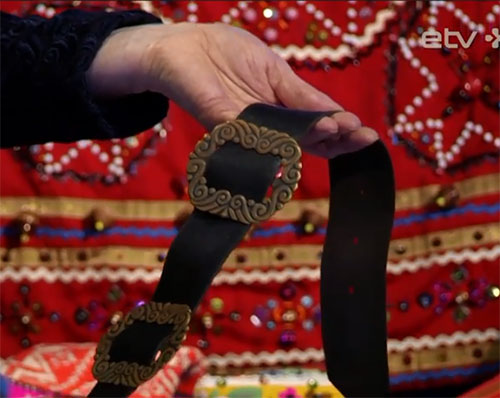
Men’s leather belt with brass buckles
A typical male outfit consisted of a linen shirt, trousers, a woven belt, outerwear, a hat (top hat or some other style of a felt hat), knitted socks, and shoes. This outerwear (woolen coat or jacket or waistcoat) was probably the most decorative part of the costume – embroidery, applique, rows of shiny buttons, belted with a bright woven or leather belt.
The women’s costume in Estonia was more complicated and diverse, there are different variations, but the most common set of clothes consisted of a linen shirt, a long striped woven skirt, a woven belt, an apron, a bodice or shawl, a headdress, jewelry, knitted socks, and shoes.
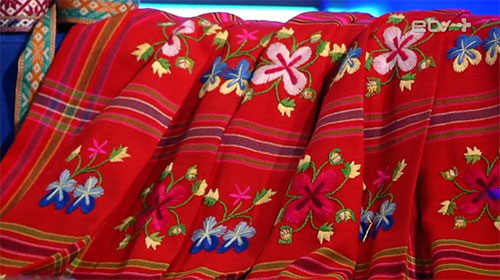
Woven and embroidered patterns on female skirt. The skirt is a modern replica
If to talk about festive attire, just about every item was richly embellished. The costume as a whole looked outstanding. All of the pieces were decorated. The skirts very often were long and wide, adorned with woven striped pattern. The shirts or dresses were embellished with embroidery and woven patterns. On bodices, aprons, and headdresses we see embroidery, lacework, beading, applique, sequins, etc.
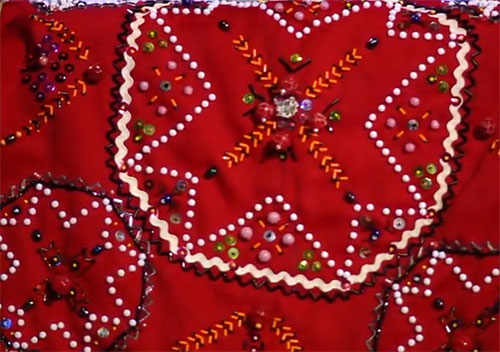
Ornate married woman’s apron adorned with embroidery, applique, beading, jingle bells, and sequins. This is also a modern replica
Estonian women, like females all around the world, liked jewels. Every festive folk costume needs some bling to look fancier. The local women wore necklaces, brooches, pins, etc. Traditionally, these pieces were made from silver and could be massive. For example, in some areas of Estonia, females wore large conical brooches that covered the chest and were believed to protect the soul of the wearer from the evil eye. Such jewelry items look really extravagant. But there were enough of more regular and familiar for people worldwide jewels, like necklaces made from silver coins, chains, crosses, jingle bells, and other pieces.
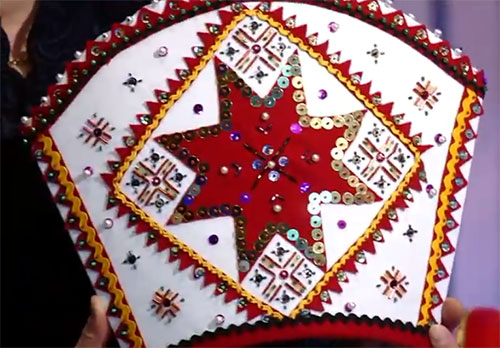
One of many Estonian women’s headdresses; modern reproduction. This one is for bride or married woman
Photos from:
